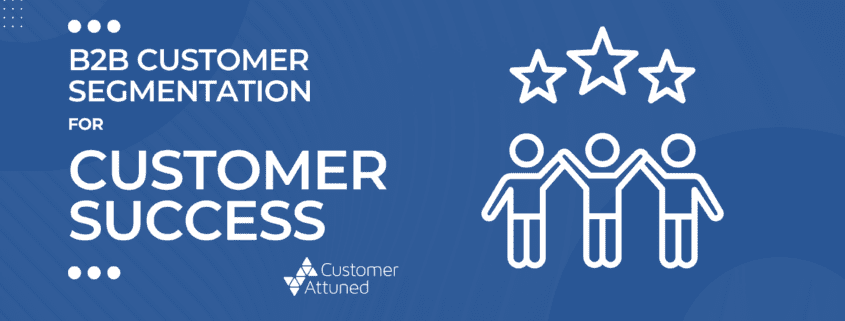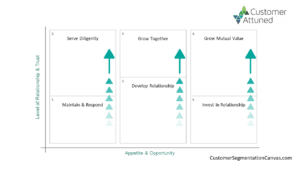Segmentation for Customer Success
Customer Attuned consultant Paul Cranston finishes his series of posts by discussing the value of Segmentation for Customer Success. This follows the first post that looks at the Customer Segmentation Canvas’s value for marketers and a second that considers Customer Segmentation for Sales Teams.
Our view is that the dimensions of the Customer Segmentation Canvas make this the first Customer Centric segmentation framework. It uses customer-specific attributes and behaviours as the means to differentiate one customer from another. Instead of using constrained data sets, such as industry or turnover.
The Customer Segmentation Canvas
Based upon Dr Mark Hollyoake’s academic research and our development of Customer Strategies, the Customer Segmentation Canvas presents the opportunity to develop customer value.
As the relationship grows and trust is built, the Customer moves up the canvas (eg, from Segment 1 to 2, or from Segment 3 to 4)
and / or through increasing the appetite and / or opportunity. This is represented by the Customer moving laterally from Segment 3 to 5, or 4 to 6.
Segmentation for Customer Success
While there are a multitude of views contributing to the concepts of Customer Success, I consider its core objectives to include the development of a relationship that enhances customers’ ongoing use of a product or service to inspire loyalty, the protection of renewals, the increase of customer lifetime value and to protect the business from churn. This post explores how using the Customer Segmentation Canvas supports these functions of Customer Success.
Develop an Ongoing Relationship
The development of a relationship is traditionally hard to qualify, let alone quantify! However, the Customer Segmentation Canvas uniquely uses the S-Curve of Trust, a model that reflects the depth of relationship as a measure. This means that the canvas allows Customer Success teams to observe improvements made through the course of engagement (ask us how 😉 !). The impact of improved relationships and deeper trust is realised in customer loyalty and retention. Moreso, there are opportunities for creating additional value – testimonials, recommendations, co-working on promotional initiatives, product and service innovations…
Increase Lifetime Value
Not so long ago there was a growth in companies focused on MRR (Monthly Recurring Revenue) – a short-term measurement that rewards quantity and not quality. When a contract price is compromised to win the sale, the long-term opportunity for increased value is hampered.
The canvas offers a pragmatic view of how and when an increase of lifetime value can be achieved. Notably, customers in Segment 1 do not want, nor is there an opportunity for further sales. However, customers in the remaining segments do have both appetite and the opportunity for more. A benefit of this Segmentation framework is that placement along the x axis, the bottom of the canvas, is influenced by the availability of additional products and the customer’s desire. This becomes a blueprint for Customer Success teams, illustrating the likely acceptability of additional products and services and, when Voice of the Customer campaigns undertaken, the appetite for more.
Prevent Churn
While a static view of Segmentation cannot prevent churn. However, a dynamic view can help track and identify movement across the Segmentation Canvas, specifically, movement downwards. When a relationship is in decline, retention, renewal or additional purchases are at risk.
With one customer, Customer Attuned integrated this approach to Segmentation with their CRM system so that there is a dynamically generated representation of the Segment that the customer sits within on their customer record. As this is dynamically generated, reports can reflect the consequence of critical activities. This might be the purchase or cancellation of a product or the submission of a Customer survey. Tracked over time, this gives the business a health check on Customer Success and highlights customers at risk.
Great Segmentation leads to Customer Success
Great Segmentation helps identify activities that achieve Customer Success teams’ core objectives and support the creation of your future best customers. It is a means to measure upwards performance (with means a growth in value) and any movement downwards. If caught quickly, Customer Success teams can save the relationship.
Our experience is that this approach to Customer Segmentation can transform your marketing, sales and customer success teams. If you would like more information, consultancy or just have questions, book a call to talk to us, and …
Download the workbook and blank canvas and the segmentation cheat-sheet by clicking on the icons below:
- AMPLIFY Account Management Training and Trust - April 14, 2025
- The Partner Relationship Survey and Trust - January 29, 2025
- The 6 Segments of Customer Segmentation - December 4, 2024




